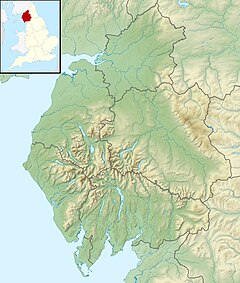Seascale Lifeboat Station was located in the village of Seascale, Cumberland, Cumbria.
| Seascale Lifeboat Station | |
|---|---|
 | |
 Site of Seascale Lifeboat Station | |
| General information | |
| Type | RNLI Lifeboat Station |
| Address | Nr. South Parade |
| Town or city | Seascale, Cumbria |
| Country | England |
| Coordinates | 54°23′43.0″N 3°29′05.0″W / 54.395278°N 3.484722°W |
| Opened | 1875 |
| Closed | 1895 |
Also known as Whitehaven No.2 Lifeboat Station, a lifeboat was first stationed here by the Royal National Lifeboat Institution (RNLI) in 1875.
After very few launches, and only one successful rescue, the station closed in 1895.[1]
History
editFollowing suggestions that for some rescues and conditions, Seascale may be a better place to launch a lifeboat, than from Whitehaven, the village was visited on 29 Aug 1874 by Capt. John Ward, RN, Inspector of Lifeboats.
His recommendation was accepted at a meeting of the RNLI Committee of Management. An order for a lifeboat was placed with Forrestt of Limehouse, London. She would be a 32-foot self righting lifeboat with 10-oars and sails (known as a Pulling and Sailing Lifeboat), and cost £273-10s-0d. A carriage cost a further £112-8s-0d.[2]
A site for a lifeboat house was made available by a local man, A. B. Steward, of Newton Manor, Gosforth, which was located at what is now the entrance to the car park. The building was constructed by a local builder, G. Torrentine, and cost £265. The whole cost of the boat, carriage, equipment and station building, said to be £800, was met by the Tomlinson sisters, of The Biggins, Kirkby Lonsdale.[3]
On Saturday, 5 June 1875, at a naming ceremony in front of the assembled crowd, many who had travelled down from Whitehaven, the boat was named William Tomlinson by the donors, in memory of their brother. Seascale lifeboat station was formally opened, and James McMinn was appointed Coxswain.[2]
Notable Rescue
editAt 1:00 am on 26 October 1875, the Isabella ran aground. It would be dawn before the vessel was seen and the alarm raised, and it would be 8:00 am before a message to alert the lifeboat crew, normally Whitehaven men, and the Whitehaven rocket brigade, was received at Whitehaven.[2]
Whitehaven Volunteer Rocket Brigade, was formed in 1849. The volunteers would haul their equipment to the coast where a ship was in distress. Rockets attached to a line were fired over the vessel, and then a much heavier cable could be drawn across, allowing the use of a Breeches buoy system to rescue passengers and crew.[4]
A special train was hastily arranged to transport all the volunteers to Seascale, but along with the rocket brigade, only 5 lifeboat men turned up. Arriving in Seascale at 9:30 am, the Isabella was too far from shore for the Rocket Brigade, so they joined the 5 lifeboat men, and some of the train crew, to man the lifeboat. Arriving at the Isabella at 11:30 am, over 10 hours since she ran aground, the three crewmen were finally rescued, and brought back to shore. And so was completed, the only successful service of the Seascale Lifeboat.[3]
Closure
editSeascale lifeboat was launched only three more times over the next twenty years, and nobody was ever rescued. A new lifeboat, Rescue (ON 77) was provided on trial in 1886, a larger 34-foot boat built by Woolfe of Shadwell, named by request of the donor, and became the station boat in 1887. However, with insufficient volunteers in Seascale, and raising and transporting a lifeboat crew from Whitehaven always proving difficult, often a rescue had been completed by the time the lifeboat was ready, on the few occasions it might have been required.
The new boat was only launched on service one time. In an ideal world, a lifeboat should never be needed, and that was the fate of the Seascale lifeboat. An RNLI Inspector visited in November 1894, to discover that no shipwrecks had occurred since the introduction of a lightship at Ravenglass. His decision was agreed by RNLI management, and the station was closed on 26 January 1895. The building was sold off for £30 in March 1895. Nothing is known of what became of the Rescue (ON 77); she never served at any other lifeboat station.[2]
Seascale lifeboats
edit| ON[a] | Name | In service[1] | Class | Comments |
|---|---|---|---|---|
| Pre-596 | William Tomlinson | 1875−1887 | 32-foot Self-righting (P&S) | |
| 77 | Rescue | 1886−1895 | 34-foot Self-righting (P&S) |
- ^ ON is the RNLI's Official Number of the boat.
- Pre ON numbers are unofficial numbers used by the Lifeboat Enthusiast Society to reference early lifeboats not included on the official RNLI list.
See also
editNotes
editReferences
edit- ^ a b Leonard, Richie; Denton, Tony (2021). Lifeboat Enthusiasts Handbook 2021. Lifeboat Enthusiasts Society. pp. 2–18.
- ^ a b c d Morris, Jeff (2011). The Story of the Whitehaven and Seascale Lifeboats. Lifeboat Enthusiasts Society. pp. 1–46.
- ^ a b Morgan, Trevor; Ramsden, Neville (1975). History of the Whitehaven (Whitehaven No. 1) and Seascale (Whitehaven No. 2) Lifeboats'. pp. 5–8.
- ^ "Honour for Rocket Brigade and Sea Cadets on Old New Quay". The Whitehaven News. 14 August 2017.
